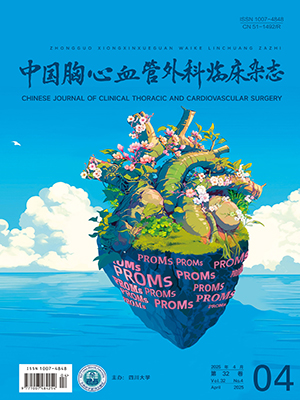| 1. |
Jinmei Z, Yunfei L, Yue W, et al. Anomalous origin of the left coronary artery from the pulmonary artery (ALCAPA) diagnosed in children and adolescents. J Cardiothorac Surg, 2020, 15(1): 90.
|
| 2. |
芮璐, 李守军, 张昌伟, 等. 左冠状动脉异常起源于肺动脉患儿86例外科治疗近期结果分析. 临床外科杂志, 2019, 27(5): 416-418.
|
| 3. |
齐玉娟, 李培军. 左冠状动脉起源于肺动脉的外科治疗进展. 中国胸心血管外科临床杂志, 2017, 24(3): 239-242.
|
| 4. |
Zhang W, Hu R, Zhu Y, et al. Surgical outcomes for anomalous left coronary artery from the pulmonary artery: Influence of late presentation. J Thorac Cardiovasc Surg, 2020, 159(5): 1945-1952.
|
| 5. |
Zheng J, Ding W, Xiao Y, et al. Anomalous origin of the left coronary artery from the pulmonary artery in children: 15 years experience. Pediatr Cardiol, 2011, 32(1): 24-31.
|
| 6. |
郑景浩, 张蔚, 何晓敏, 等. 婴幼儿重症ALCAPA手术治疗的临床初探. 中华胸心血管外科杂志, 2019, 35(3): 140-144.
|
| 7. |
Edwin F, Kinsley RH, Quarshie A, et al. Prediction of left ventricular assist device implantation after repair of anomalous left coronary artery from the pulmonary artery. J Thorac Cardiovasc Surg, 2012, 144(1): 160-165.
|
| 8. |
Sasikumar D, Dharan BS, Arunakumar P, et al. The outcome of mitral regurgitation after the repair of anomalous left coronary artery from the pulmonary artery in infants and older children. Interact Cardiovasc Thorac Surg, 2018, 27(2): 238-242.
|
| 9. |
Ismail M, Jijeh A, Alhuwaymil RM, et al. Long-term outcome of the anomalous origin of the left coronary artery from the pulmonary artery (ALCAPA) in children after cardiac surgery: A single-center experience. Cureus, 2020, 12(12): e11829.
|
| 10. |
Mishra A. Surgical management of anomalous origin of coronary artery from pulmonary artery. Indian J Thorac Cardiovasc Surg, 2021, 37(Suppl 1): 1-13.
|
| 11. |
Di Salvo G, Siblini G, Issa Z, et al. Left ventricular mechanics in patients with abnormal origin of the left main coronary artery from the pulmonary trunk late after successful repair. Cardiology, 2017, 136(2): 71-76.
|
| 12. |
Zhang C, Zhang H, Yan J, et al. Mid-term outcome for anomalous origin of the left coronary artery from the pulmonary artery. Heart Lung Circ, 2020, 29(5): 766-771.
|
| 13. |
Ma K, Wang L, Hua Z, et al. Outcomes of coronary transfer for anomalous origin of the left coronary artery from the pulmonary artery. Eur J Cardiothorac Surg, 2015, 47(4): 659-664.
|
| 14. |
Nasseri BA, Alexi-Meskishvili V, Nordmeyer S, et al. Predictors for the use of left ventricular assist devices in infants with anomalous left coronary artery from the pulmonary artery. Ann Thorac Surg, 2010, 90(2): 580-587.
|
| 15. |
Wang J, Wang C, Wang Y, et al. Fluid overload in special pediatric cohorts with anomalous origin of the left coronary artery from the pulmonary artery following surgical repair. J Cardiothorac Vasc Anesth, 2020, 34(6): 1565-1572.
|
| 16. |
Gist KM, Henry BM, Borasino S, et al. Prophylactic peritoneal dialysis after the arterial switch operation: A retrospective cohort study. Ann Thorac Surg, 2021, 111(2): 655-661.
|
| 17. |
Wu Y, Zhao T, Li Y, et al. Use of extracorporeal membrane oxygenation after congenital heart disease repair: A systematic review and meta-analysis. Front Cardiovasc Med, 2020, 7: 583289.
|




